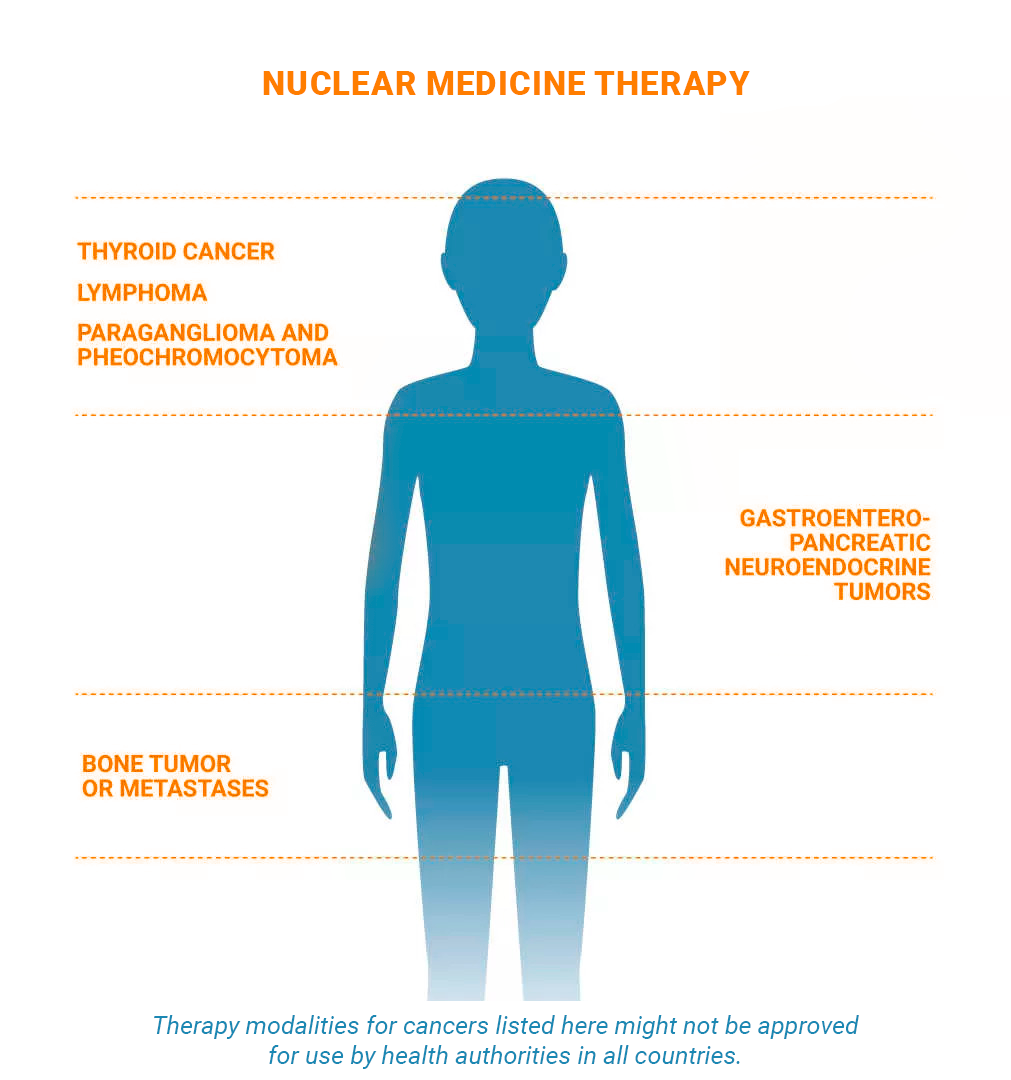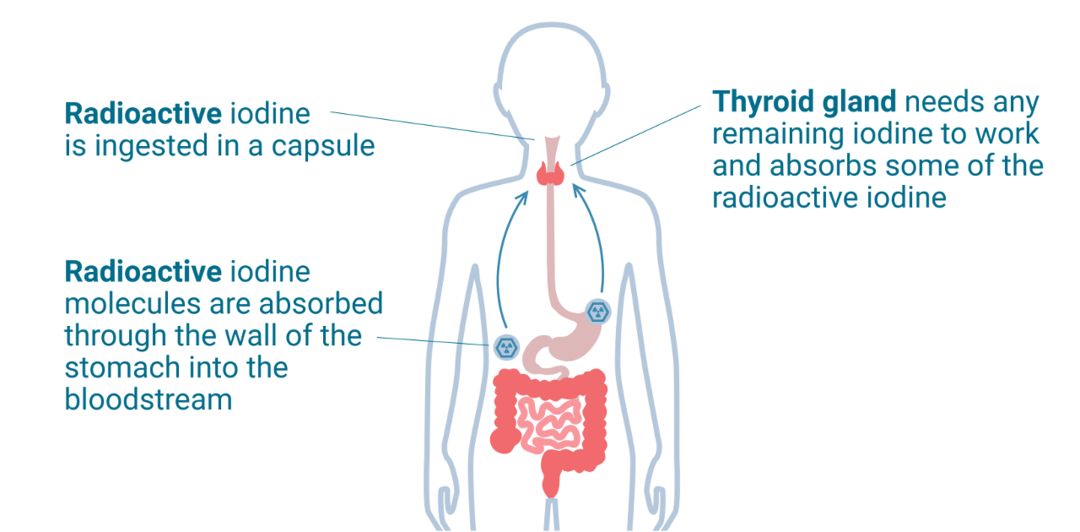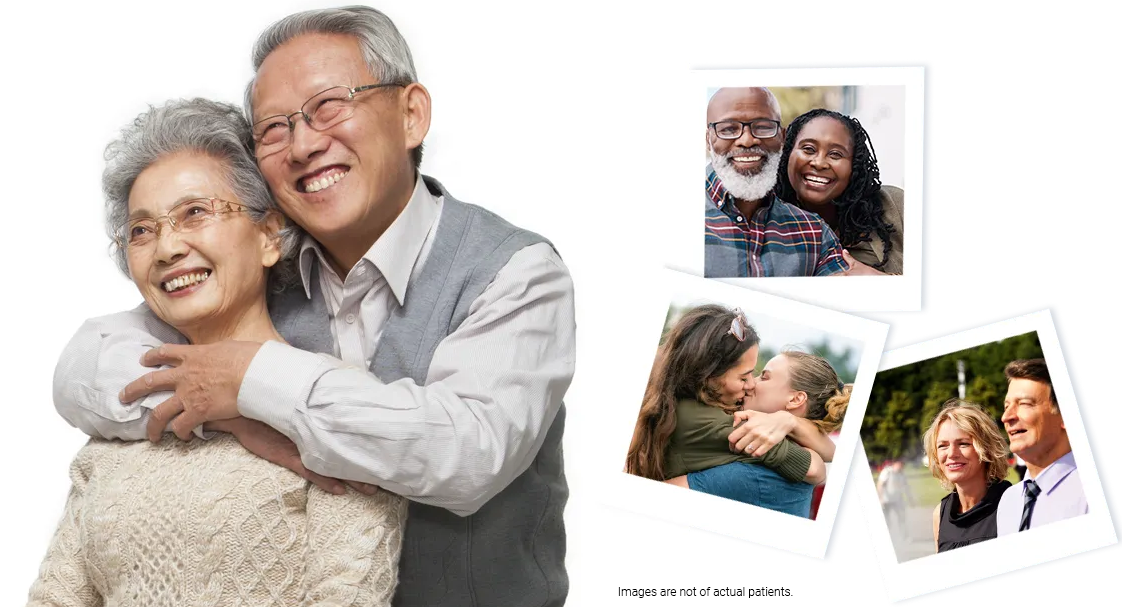
WHEN IS IT USED?
Nuclear medicine therapy – also called radionuclide, radioisotope, or radioligand therapy – is used by doctors to treat certain types of cancer, benign thyroid disease, certain blood disorders and inflammatory joint diseases, and to relieve pain from bone metastases.1-3
Researchers are actively working to develop new radiopharmaceuticals for the treatment of other types of cancer and other diseases.
HOW DOES IT WORK?
Nuclear medicine therapies use radiopharmaceuticals or radioisotopes/radionuclides that are designed to target the diseased areas inside your body.4
They deliver radiation internally at a specific site to damage or destroy target cells and nearby cells, with generally low radiation exposure to other healthy tissues and organs.4
IN NUCLEAR MEDICINE THERAPY PROCEDURES:
- • A therapeutic radiopharmaceutical is administered or given to a patient5
- • It searches for and travels to a specific tissue or organ5
- • It releases a type of radiation that causes damage to targeted cells and surrounding tissue5
HOW ARE NUCLEAR MEDICINE TREATMENTS ADMINISTERED?
Depending on the specific therapy you are receiving, the radiopharmaceutical may be swallowed or injected.
- • To treat different types of thyroid disease, radioactive iodine is usually swallowed in a capsule or liquid form and then passes from the gut to the bloodstream so it can reach the thyroid gland1,2
- • For the treatment of certain other types of cancers, a radiopharmaceutical may be delivered into the bloodstream either intravenously (into a vein) or intra-arterially (into an artery) depending on the treatment requirements6,7
- • For inflammatory joint disease, the radiopharmaceutical is typically injected directly into the joint2,8
HOW DO THE TREATMENTS GET TO THE PLACES WHERE THEY ARE NEEDED IN THE BODY?
There are several methods of delivery to get a radiopharmaceutical to the site of disease.4,9
Specific tissue attraction
Some delivery agents are chosen for their ability to be naturally attracted to or absorbed by a particular organ or tissue.4
- • For example, iodine is naturally absorbed by the thyroid gland to produce thyroid hormones
- • Radiopharmaceuticals using samarium and strontium are naturally capable of substituting for calcium in the bone and so they are absorbed by bone cells

SPECIFIC CELL MARKER OR CELL PATHWAY TARGETING
Some delivery agents are created in the laboratory to mimic the action of natural molecules and connect or bind to specific cell markers.9

HOW DOES NUCLEAR MEDICINE THERAPY TREAT DISEASE?
The radiopharmaceuticals used in therapy are either absorbed by or attach to their target cells and damage and/or destroy them by giving off radiation.

WHAT WILL I EXPERIENCE?
In this section, you will find some answers to the different types of questions that you may have if you need to undergo a nuclear medicine treatment.

HOW DO I PREPARE FOR TREATMENT?
Depending on the type of treatment you are having, you will be given specific instructions on how to prepare. It is always a good idea to ask questions to your health care team to make sure you understand if there are any special preparations or restrictions prior to treatment.
• You may need to stop taking certain medications several days or weeks before the nuclear medicine treatment10,11
• Often, certain laboratory tests are done prior to treatment11
• You will likely be asked questions about how you feel and about your daily activities to help your health care team determine how the therapy will be administered and also what level of precautions in your daily life will be necessary to reduce the radiation exposure of other people after your treatment11
There are a number of precautions you will need to be aware of. A discussion with your health care team about your individual circumstances and treatment will be important. Please tell your doctor:
• If you are or may be pregnant. Many nuclear medicine services require all women of childbearing age to have a pregnancy test within 24 hours before therapy10,11
• If you are breastfeeding10,11
• If you are incontinent (have trouble controlling your bladder)10
• If you have nausea or feel like you might vomit11
• If you are using any prescribed or over-the-counter medication for any reason
• If you had surgery, chemotherapy, or radiotherapy
• If you had nuclear medicine therapies in the past
• If you have any allergies (medicine, food, etc)
HOW IS THE TREATMENT PERFORMED?
• Nuclear medicine treatments are typically performed in a medical clinic, in a private room with a private bathroom. Sometimes visitors are allowed to be with you for certain parts of the procedure
• The radiopharmaceutical may be delivered by an injection into a vein or artery, or given by mouth, depending on your treatment protocol.6,7 In some cases, other medications may be given to you before or during the nuclear medicine treatment11
• Depending on the type of therapy you are receiving, a single dose may be sufficient or several treatment doses may be required.10 Your health care team should provide this information
• During treatment, some people may feel pain or discomfort associated with an injection or the insertion of an intravenous drip. Depending on the type of treatment you receive, you may feel other discomfort related to treatment administration during treatment.11 As with many medicines, individuals may react very differently, so it is always good to discuss any concerns or previous experiences with your health care team
WHAT HAPPENS AFTER THE TREATMENT?
It is always a good idea to ask questions to your health care team to make sure you understand any special precautions or restrictions that you need to be aware of following your treatment.
Can I go home after treatment?
• Depending on the type of treatment you are receiving, it may be performed on an outpatient or day patient basis, meaning that you will not need to stay in the clinic/hospital overnight.10 However, for some treatments, you may have to stay overnight or for a few days to make sure that any radioactive excretions are disposed of safely when they leave your body.10 If you are required to stay in a medical clinic, you may be placed in an isolation room (by yourself) for a few days to limit radiation exposure to other people11
• The radioactivity level in your body will be checked regularly in order to decide when you can leave the medical clinic6
Do I need to take certain precautions?
As a nuclear medicine therapy patient, you may need to take some safety measures depending on the type of therapy you receive in order to protect yourself and other people from the radiation that you have been given.10 Common recommendations include:
• Drinking a lot of water as most of the radiopharmaceutical leaves the body when you urinate1
• Using the toilet in a seated position, using toilet paper to wipe (including men) and wiping up any spilled urine with toilet paper, flushing the toilet twice after each use, and washing hands thoroughly after using the toilet10
• Washing your hands thoroughly before preparing food10,11
• Showering daily to remove sweat, as bodily excretions or fluids may contain some radiation2
• Washing bed linen, towels, and clothes separately from those of other people in the family10
• Limiting the time spent in close contact with people and especially avoiding contact with pregnant women and small children. This could mean that you need to stay 1 arm's-length away from people, avoid public transportation, avoid sharing a bed with a spouse or partner, and not go to work for a period of time10,11
• Not become pregnant, or father a child, for a certain period of time after some types of therapy12
• Breastfeeding is to be completely avoided for a period of time following nuclear medicine therapy12
What if I have to travel for treatment?
It is recommended to speak with your health care team regarding any special considerations when traveling. Depending on the type of treatment you are receiving:
• It may be necessary to wait a certain period of time before flying or using other modes of public transportation such as trains or buses to avoid close proximity to others.6 Similarly, if you are traveling by car, it may be recommended to sit by yourself in the back seat, away from the driver
• If you travel in the period immediately following discharge, you may trigger sensitive radiation detectors that can be found at airports and border crossing points. These detectors are designed to detect even low levels of radioactivity. The security authorities are aware of this possibility, and if you are likely to travel soon after discharge, your health care team should provide a written statement to carry with you describing the therapy and the radionuclide or radioisotope used11
• It may be recommended to travel with your own bed linens or to use a mattress protector to avoid any potential contamination10
Who will follow up and how?
• Your health care team will follow up with you after treatment to see how you are feeling, to check how your disease is responding to therapy, and to see whether you have any side effects related to your treatment13-15
• You will likely have regular follow-up consultations in the following weeks or months. Some of these follow-up consultations may involve imaging and laboratory tests. These consultations will take place either at the medical clinic or with your referring doctor.13-15 In some cases, patients may require a life-long follow-up13
Please be sure to discuss any potential risks, side effects, or other precautions specific to your treatment with your health care team.
HOW IS NUCLEAR MEDICINE THERAPY MONITORED?
Your doctor will monitor how well your treatment has worked in the weeks or months following your procedure. This is often called treatment response.4
Your doctor may measure your treatment response with different types of imaging scans as well as laboratory tests in order to see how your disease has changed. Nuclear medicine scans are often used to assess the effectiveness of a treatment.4 Your doctor may also ask you questions about how you feel to assess your symptoms and/or evaluate any changes to your overall health or quality of life.14
MONITORING CANCER TREATMENT
If you have gone through a nuclear medicine treatment for cancer, your doctor may compare your tumor size and/or function before and after treatment to see how much it has changed and evaluate how well the treatment worked.4
Below are different words your doctor may use to explain how your cancer has responded to treatment:
Complete response: There are no signs of cancer on scans or tests.16 It is also called complete remission.17
Partial response: The cancer has shrunk by at least 30% and there are no signs the cancer has grown anywhere else in the body.16 This is also called partial remission.17
Stable disease: The cancer has stayed the same size; it has not gotten better or worse.16
Disease progression: The cancer has grown by a certain percentage or there are new areas of cancer.16
Recurrence: The cancer has returned after it had gone away.16
Relapse: The cancer has started to grow again after it had gotten smaller or stopped growing.16
Treatment with nuclear medicine therapy will expose you to radiation,
which can contribute to your long-term radiation exposure.
It is recommended that all patients follow the instructions provided by the treating physician and health care team at the treatment center.
The following are additional commonly recommended precautions:

Drinking a lot of water as most of the radiopharmaceutical leaves the body when you urinate.1

Using the toilet in a seated position, using toilet paper to wipe (including men) and wiping up any spilled urine with toilet paper, flushing the toilet twice after each use, and washing hands thoroughly after using the toilet.10

Washing your hands thoroughly before preparing food.10,11
Showering daily to remove sweat, as bodily excretions or fluids may contain some radiation.2
Washing bed linen, towels, and clothes separately from those of other people in the family.10

Limiting the time spent in close contact with people and especially avoiding contact with pregnant women and small children. This could mean that you need to stay 1 arm's-length away from people, avoid public transportation, avoid sharing a bed with a spouse or partner, and not go to work for a certain number of days.10,11

Not become pregnant, or father a child, for a certain period of time after some types of therapy.12

Breastfeeding is to be completely avoided for a period of time following nuclear medicine therapy.12
Please be sure to discuss any potential risks, side effects, or other precautions specific to your treatment
with your health care team and contact your doctor if any symptoms occur after treatment.
Please also refer to "Important information about radiation".
References:
1. Radiological Society of North America. General nuclear medicine. https://www.radiologyinfo.org/en/info.cfm?pg=gennuclear. Accessed June 6, 2020. 2. International Atomic Energy Agency. Specific therapies involving radiation. https://www.iaea.org/resources/rpop/health-professionals/nuclear-medicine/therapeutic-nuclear-medicine/specific-therapies. Accessed June 15, 2020. 3. Society of Nuclear Medicine and Molecular Imaging. Targeted cancer treatment with nuclear medicine therapy. Available at: https://www.snmmi.org/therapyinfographic. 4. Kramer-Marek G, Capala. The role of nuclear medicine in modern therapy of cancer. J. Tumor Biol. 2012;33:629-640. 5. Zimmerman R. Nuclear Medicine Radioactivity for Diagnosis and Therapy. Les Ulis, France: EDP Sciences; 2007. 6. International Atomic Energy Agency. General issues in therapeutic nuclear medicine. https://www.iaea.org/resources/rpop/health-professionals/nuclear-medicine/therapeutic-nuclear-medicine/general-issues. Accessed June 15, 2020. 7. Chauhan N, Bukovcan J, Boucher E et al. Intra-Arterial TheraSphere Yttrium-90 Glass Microspheres in the Treatment of Patients With Unresectable Hepatocellular Carcinoma: Protocol for the STOP-HCC Phase 3 Randomized Controlled trial. JMIR Res Protoc. 2018;7(8):e11234. 8. Chojnowski MM, Felis-Giemza A, Kobylecka M. Reumatologia. Radionuclide synovectomy – essentials for rheumatologists. 2016;54(3):108-116. 9. Society of Nuclear Medicine and Molecular Imaging. Peptide Receptor Radionuclide Therapy (PRRT). http://www.snmmi.org/Patients/Procedures/Content.aspx?ItemNumber=14796. Accessed June 16, 2020. 10. Australasian Association Nuclear Medicine Specialists. Information about your nuclear medicine therapy. 2014. Available at: https://aanms.org.au/wp-content/uploads/2020/02/2014_AANMS_NM_Therapy_Info_Mobile.pdf. 11. International Atomic Energy Agency. Radiation protection of patients in therapeutic nuclear medicine. https://www.iaea.org/resources/rpop/health-professionals/nuclear-medicine/therapeutic-nuclear-medicine/patients. Accessed June 15, 2020. 12. International Atomic Energy Agency. Radiation protection of pregnant women in therapeutic nuclear medicine. https://www.iaea.org/resources/rpop/health-professionals/nuclear-medicine/therapeutic-nuclear-medicine/pregnant-women. Accessed June 15, 2020. 13. Luster M, Clarke SE, Dietlein M et al. Guidelines for radioiodine therapy of differentiated thyroid cancer. Eur J Nucl Med Mol Imaging. 2008;35:1941. 14. Bodei L, Mueller-Brand J, Baum RP et al. The joint IAEA, EANM, and SNMMI practical guidance on peptide receptor radionuclide therapy (PRRNT) in neuroendocrine tumors. Eur J Nucl Med Mol Imaging. 2013;40:800-816. 15. Giammarile F, Bodei L, Chiesa C et al. EANM procedure guideline for the treatment of liver cancer and liver metastases with intra-arterial radioactive compounds. Eur J Nucl Med Mol Imaging. 2011;38:1393. 16. Cancer Research UK. What do clinical trial results mean? https://www.cancerresearchuk.org/find-a-clinical-trial/clinical-trial-results/what-do-clinical-trial-results-mean?_ga=2.52725032.12229732.1592397244-712054882.1592397244. Accessed June 17, 2020. 17. National Cancer Institute. NCI dictionary of cancer terms. https://www.cancer.gov/publications/dictionaries/cancer-terms. Accessed November 24, 2020. 18. Silberstein EB, Alavi A, Balon HR et al. The SNMMI practice guideline for therapy of thyroid disease with 131I 3.0. J Nucl Med. 2012;53(10):1633-1651.
